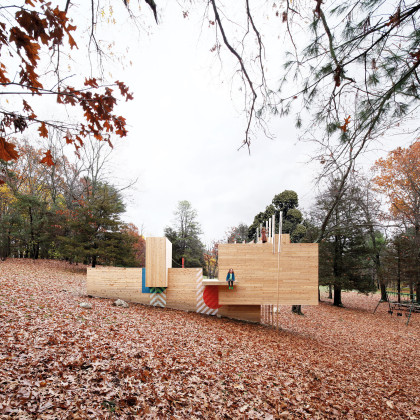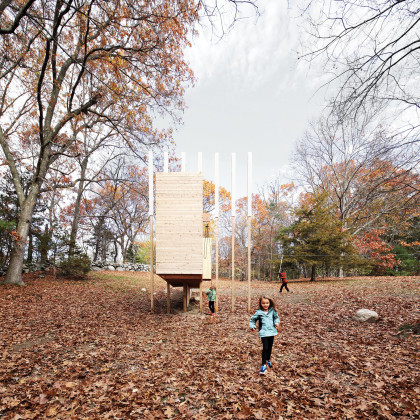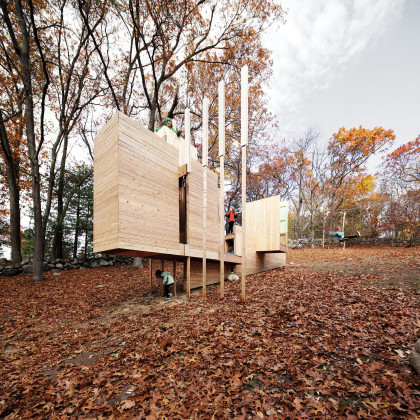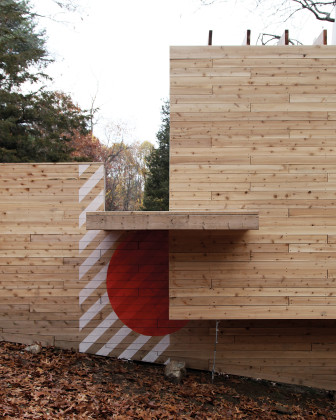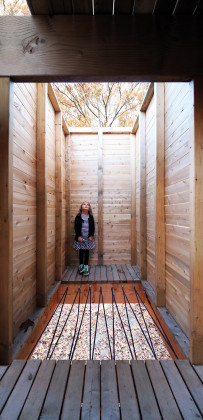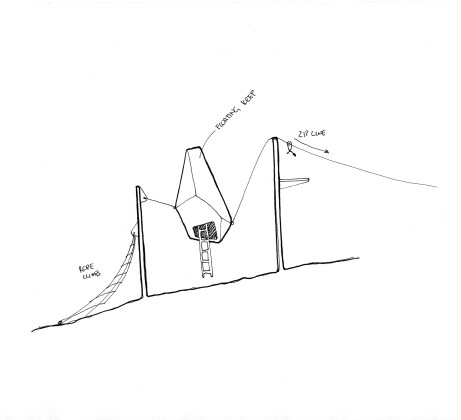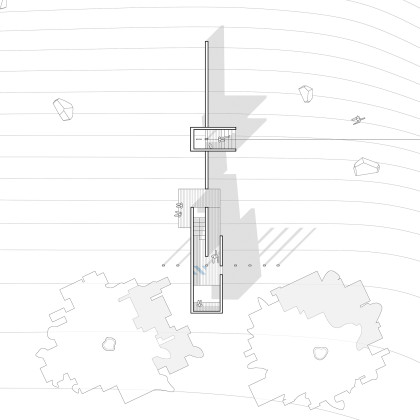A Play Experience
The play structure, which is designed in a neighborhood that has been developed to foster community through creating common land in the first place, cultivates children’s imagination through play
Five Fields Play Structure has no purpose. And that is exactly how we intend for it to be. The project is a landscape for childish exploration. It shuns function and standard, in favor of liberation. The structure cultivates a child’s—and our own—imagination through play. It encourages inventiveness through its unfolding, discoverable spaces. The playscape is tailored to child size, but still accessible to adults. It prioritizes the child user, in order to both liberate and educate. It invites the older user to reminisce, and rediscover. The structure is a space for collective imagining and celebrating of all ages.
Five Fields Play Structure is positioned on land that is rich in history. The Five Fields neighborhood was designed and developed by The Architects Collaborative (TAC) in the early 1950s. TAC sought to foster community through creating shared, common land. Since its inception, the community has cared and respected the land as a whole. This land was conceived of as an experiment over sixty years ago. TAC’s experiment was a success—the upkeep and care of the common land unifies the community to this day. We seek to keep the spirit of communal innovation alive. Five Fields Play Structure is in this sense a monument to collective experimentation. It commends the exploratory spirit of the child, as nurtured by a whole community. As they say, it takes a village. We think it also takes a village to truly imagine, to truly play.
The thing is, the act of play is inherently indeterminate. Play cannot be reined in by a specific set of verbs. Play is liberation, but also irresolution. So how do you design for ambiguity, but also childish experimentation? We designed this structure with the hope to release users from specified, directive use. The expectation is that all users will inscribe their individual, creative means of expression through the space. The play structure harnesses the imagination and liberates the body within its wooden volumes.
Which brings us to the materiality, the sensorial aspects, of this playscape. A diverse body of elements engage the senses and augment each user’s experience. Just as each child learns differently in school, so this playscape offers diverse but equal means of engagement. Visual, auditory, and kinesthetic elements create distinct moments of use. The playscape is an unfolding of views, movements, and spaces. Levitating volumes overlap at certain points to create hidden thresholds. Smaller children crawl, while larger ones climb, as a varied means of reaching discoverable spaces. Colorful graphics suggest entries and moments of use, without being overtly prescriptive. Elements like doors and stairs exist, but not as expected. We wanted to render architecture as childish. Movement through the playscape culminates in dead ends. But to the child, they are vistas of discovery that look out onto the landscape.
We see the Five Fields Play Structure as a learning opportunity. We have a lot to learn from children, from our younger selves. By creating safe space for community play, we let imagination reign. The play structure is both nod to and continuation of TAC’s emphasis on community sharing. This is a space celebrating the collective imagination, as a shared experience. It seeks to reinforce the neighborhood’s relationship to the land and to each other. Continuing TAC’s heritage, the play structure is an experimental extension of pre-existing play equipment (which already include swings, slides, and a sandbox). This investigation in ambiguity and abstractness is not just a creative endeavor. It also serves to open the very playful imagination that it is designed for. The intent is to not ask what the structure does, but how it imagines new possibilities.
Related Content:
-

Geometric Landscape
-

Exploration In-Between Folds
-
Social Design for Beginners
Curated by Angeli Sachs, Social Design exhibition in the Museum for Gestaltung Zurich aims to discuss implications of growth economy on human beings, environment and design. Banu Çiçek Tülü reviewed the exhibition as a good example of inclusiveness in a country where democratic design processes emerge in urban scale.
-
Learning From Change
In conversation with Jan Boelen, the curator of 4th Istanbul Design Biennial on the theme of "A School of Schools." We discussed a variety of issues starting from the making of a design biennial up to design's capacity to respond to changes in the society.
-
New Forms of Conviviality
Hulya Ertas talked with Cristina Gamboa, one of the founder members of Lacol, on their approach as an architecture cooperative
-
The Culture of the Ephemeral, Conglomerate, and Transient
Sex and the So-Called City exhibition investigates the factors that shaped the city’s urban lifestyle and cultural trends during late 1990s and early 2000s.
-
Seeds of Awareness
In the guidance of Michael Leung, this interview looks into a collective movement that flourishes at a street stall in Hong Kong as a reaction to the current development plans
-

Following the Traces
 26.03.2018
26.03.2018



